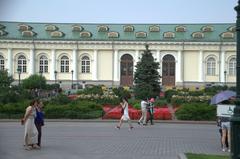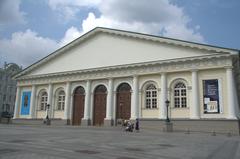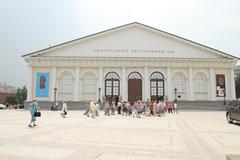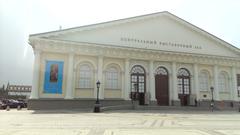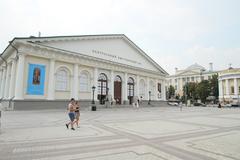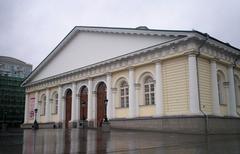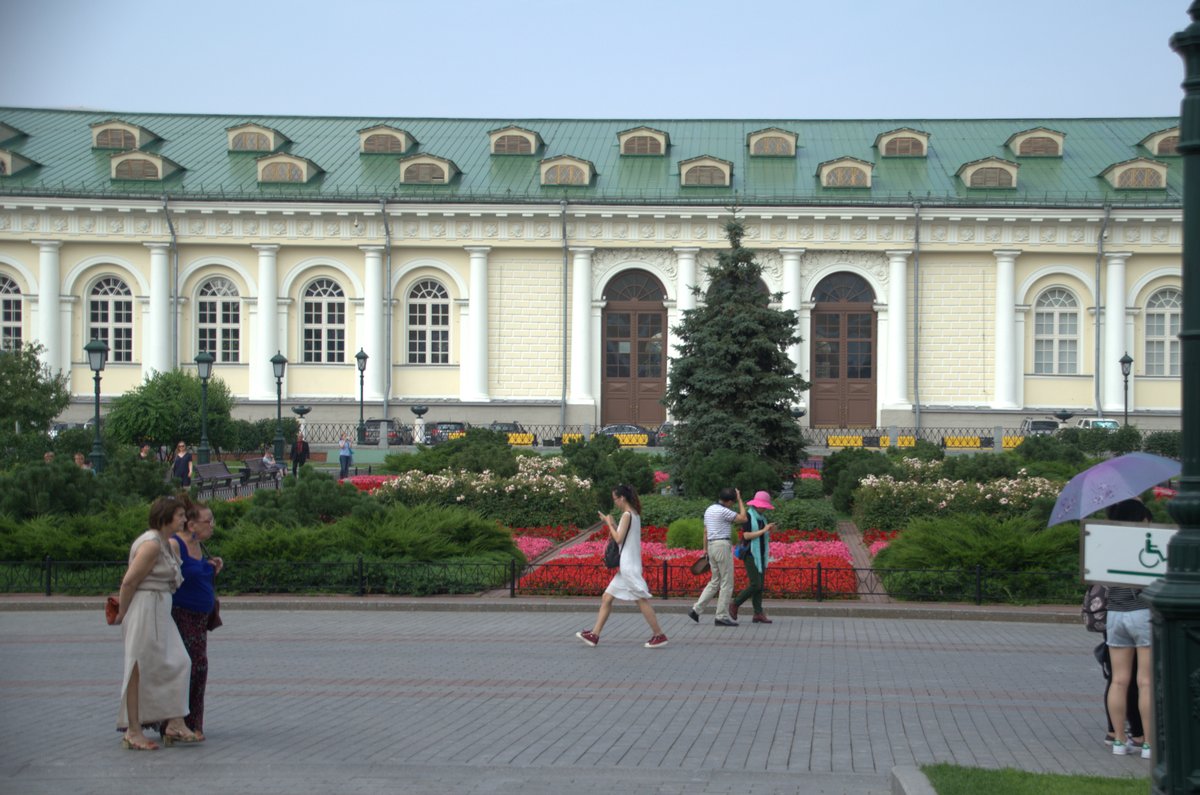
Moscow Manege Visiting Hours, Tickets, and Guide to Moscow Historical Sites
Date: 14/06/2025
Introduction
Nestled in the vibrant heart of Moscow, the Moscow Manege is an essential cultural and architectural landmark. Since its completion in 1817, the Manege has transformed from a grand military riding academy to one of Russia’s premier exhibition and event spaces. Its pioneering column-free design, conceived by Spanish engineer Agustin de Betancourt and architect Joseph Bové, set a new standard for architectural innovation (Geomerid, Wikipedia).
Located on Manezhnaya Square, adjacent to the Kremlin, Red Square, and Alexander Garden, the Manege’s walls have witnessed imperial celebrations, Soviet art debates, and some of Moscow’s most vibrant contemporary exhibitions. Today, it stands as a testament to Russia’s evolving cultural landscape and offers visitors a gateway to Moscow’s heritage (Advantour, Moscow Manege official site).
This guide provides detailed information on visiting hours, ticketing, accessibility, travel tips, and nearby attractions, ensuring you make the most of your visit to the Moscow Manege and the historical heart of Moscow.
Table of Contents
- Introduction
- Visiting the Moscow Manege: Hours, Tickets & Accessibility
- The History and Architecture of the Moscow Manege
- Manege Square and Nearby Attractions
- Travel Tips for Visiting the Moscow Manege
- Frequently Asked Questions (FAQ)
- The Manege’s Cultural and Social Significance
- Practical Visitor Information
- Visitor Experience and Facilities
- Summary and Final Recommendations
- References
Visiting the Moscow Manege: Hours, Tickets & Accessibility
Visiting Hours:
- Typically open Tuesday to Sunday, 12:00–22:00; closed on Mondays. Hours may vary for special events—check the official website before your visit.
Tickets:
- Standard pricing for exhibitions: 250 RUB for adults, 50 RUB for students, seniors, and children. Tickets are available at the entrance and online (Moscow Manege official site).
- Due to sanctions, foreign-issued bank cards (Visa, Mastercard, American Express) are not accepted. Bring cash in RUB or obtain a Russian payment card (Owl Over The World).
Guided Tours & Special Events:
- Guided tours in Russian and English can be booked in advance. The Manege hosts a rotating calendar of exhibitions, art fairs, and cultural festivals—see the events calendar.
Accessibility:
- The Manege is fully wheelchair accessible, with ramps, elevators, and accessible restrooms. Audio guides and multilingual signage are available for major exhibitions.
Photography:
- Non-flash photography for personal use is typically permitted, but some exhibitions may restrict photography. Check signage or consult staff.
The History and Architecture of the Moscow Manege
Origins and Construction
Commissioned in 1817 by Emperor Alexander I to commemorate Russia’s victory in the Patriotic War of 1812, the Manege was designed by Agustin de Betancourt with Joseph Bové overseeing its neoclassical style. The building’s most remarkable feature is its column-free hall, spanning 45 meters—an engineering marvel of its time (Geomerid).
Early Functions and Evolution
Initially serving as a riding academy and parade hall for the imperial army, the Manege quickly became a venue for public events, balls, and state celebrations. By the late 19th century, it was renowned for hosting concerts and major gatherings.
Twentieth-Century Transformations
After 1917, the Manege functioned as a government garage, reflecting the political shifts of the Soviet era. In 1957 it reopened as the Central Exhibition Hall, cementing its status as a premier venue for Soviet art and cultural exhibitions. The 1962 “Manege Affair,” where avant-garde artists were denounced by Nikita Khrushchev, marked a pivotal moment in Russian art history (Wikipedia).
Restoration and Modern Use
A devastating fire in 2004 destroyed much of the original structure. Restoration, completed in 2005, preserved the Manege’s historical character while expanding exhibition space and modernizing facilities. Today, it houses major art exhibitions and serves as a hub for Moscow’s cultural life (Advantour).
Manege Square and Nearby Attractions
Manege Square is a lively public space with fountains, sculptures, and gardens. It sits at the crossroads of Moscow’s most famous landmarks:
- Red Square: Iconic site with St. Basil’s Cathedral and State Historical Museum (The Expat).
- The Kremlin: Russia’s historical and political heart, with museums and cathedrals.
- Alexander Garden: A tranquil park ideal for walks and relaxation.
- Tverskaya Street: Main thoroughfare for shopping and dining.
- GUM Shopping Center: Historic shopping arcade with luxury boutiques and cafes.
Travel Tips for Visiting the Moscow Manege
- Getting There:
Use the Moscow Metro; Okhotny Ryad, Alexandrovsky Sad, and Biblioteka Imeni Lenina are all within a 5-minute walk. - Tickets:
Buy online to avoid queues during popular exhibitions. - Language:
English signage is common, but staff English proficiency varies. Learn key Russian phrases or use a translation app (Owl Over The World). - Weather:
Dress for Moscow’s changing seasons, especially in winter. - Security:
Expect bag checks at the entrance. Leave large bags in the cloakroom. - Connectivity:
Free Wi-Fi is available. Consider a local SIM card for mobile data. - Payment:
Bring cash due to international card restrictions.
Frequently Asked Questions (FAQ)
Q: What are the Moscow Manege visiting hours?
A: Tuesday to Sunday, 12:00–22:00; closed on Mondays. Check the official website for updates.
Q: Where can I buy tickets?
A: At the entrance or online. Cash payments in RUB are recommended for foreigners.
Q: Is the Manege wheelchair accessible?
A: Yes, with ramps, elevators, and accessible restrooms.
Q: Can I take photos inside?
A: Non-flash photography is generally allowed; check exhibition-specific policies.
Q: What landmarks are nearby?
A: Red Square, the Kremlin, Alexander Garden, Tverskaya Street, and GUM.
Q: Are foreign bank cards accepted?
A: No, due to sanctions. Bring cash or arrange a Russian bank card.
The Manege’s Cultural and Social Significance
Symbolism and Architectural Heritage
The Manege’s neoclassical design and innovative roof structure are emblematic of Moscow’s ambition and resilience. Its military motifs and placement near Red Square reinforce its status as a monument to national pride (Advantour, Wikipedia).
Evolution as a Cultural Venue
From hosting the 19th-century imperial court to becoming a Soviet and now international exhibition hall, the Manege reflects Moscow’s cultural evolution. Its role in the “Manege Affair” and later as the home of the Moscow Design Museum highlight its ongoing significance (Wikipedia).
Community and Educational Role
The Manege offers guided tours, lectures, and workshops, engaging audiences of all ages. It’s a central gathering point for city festivals, parades, and the Night of Museums, making it an inclusive space for all Muscovites (ETS Russia Travel).
Integration in Festive Life
During events like Moscow City Day and the Circle of Light Festival, the Manege becomes a focal point for multimedia shows and celebrations, drawing thousands to its illuminated façade (Russia E-Guide).
Preservation and Continuity
The rapid restoration after the 2004 fire demonstrated Moscow’s dedication to cultural heritage. The Manege stands as a model for adaptive reuse and historical preservation in the city (Wikipedia).
Practical Visitor Information
Address and Access
- Address: Manezhnaya Square, 1, Moscow 125009
- Metro Stations: Okhotny Ryad, Alexandrovsky Sad, Biblioteka Imeni Lenina (Moscow Manege official site)
Facilities
- Cloakroom: Free service for coats and bags.
- Restrooms: Modern and accessible.
- Café: Onsite café with light meals and drinks.
- Gift Shop: Exhibition catalogs and souvenirs.
- Wi-Fi: Free throughout the building.
- Accessibility: Full access for visitors with limited mobility.
Visitor Experience and Facilities
- Exhibition Spaces: Over 12,000 square meters of flexible exhibition halls with natural light and open-plan design.
- Programming: Regular exhibitions, lectures, film screenings, and workshops in collaboration with Russian and international partners.
- Atmosphere: Cosmopolitan, welcoming, and vibrant, attracting both locals and tourists.
- Conduct: Respectful behavior is expected; food/drink not allowed in galleries.
- Photography: Allowed in most areas, but restrictions apply to some exhibitions.
Summary and Final Recommendations
The Moscow Manege is a cornerstone of Moscow’s cultural scene—a place where the city’s imperial past, Soviet legacy, and contemporary creativity converge. Its central location, accessible facilities, and dynamic programming make it an essential stop for any visitor to Moscow. Plan ahead by checking exhibition schedules and ticketing policies, bring cash for payments, and allow time to explore the surrounding historical sites for a rich and immersive experience (Geomerid, Advantour, Moscow Manege official site).
For further information and personalized travel tips, download the Audiala app and follow local culture channels for real-time updates.
References
- Geomerid: Manege in Moscow Travel Guide
- Wikipedia: Moscow Manege
- Advantour: Moscow Manege - Interesting Places in Moscow
- Moscow Manege official site: Manege Central Exhibition Hall
- Owl Over The World: Moscow Travel Tips
- ETS Russia Travel: Moscow Events Calendar
- Russia E-Guide: Moscow Events
- The Expat: State Historical Museum
- Agenda 21 Culture: Moscow
